8 Highest Rated Motorcycle Batteries
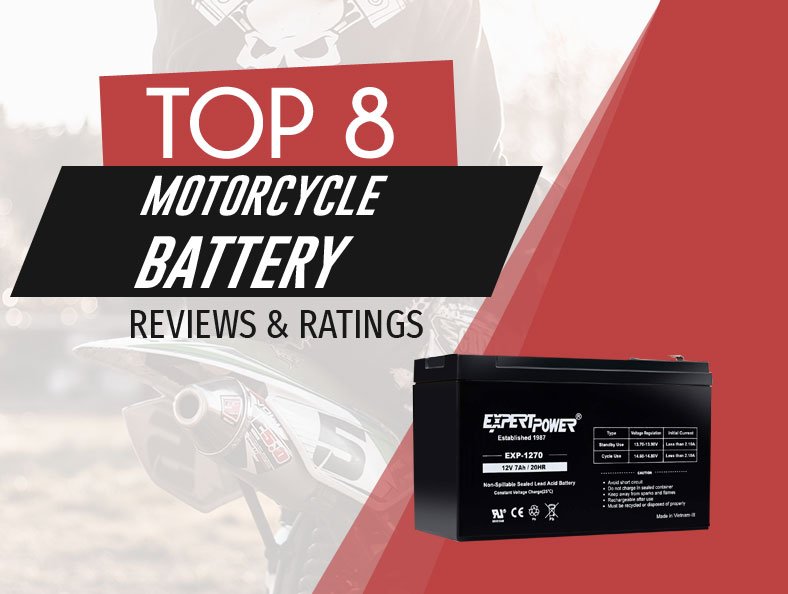
Road Racerz is proudly supported by our readers. Products purchased through links on our site may provide us a commission. Learn More
Having a reliable motorcycle battery is among the essential things to pay attention to. It’s a vital part of your bike that starts and moves it.
Riding a bike is about more than just transportation and commuting. It’s fun, enjoyable and provides a sense of freedom you don’t get with any other vehicle. For this reason, you should pay special attention to the quality of your bike’s battery.
You want one that can hold up, so make sure to consider only the high-quality ones. Take a moment to read about some of the best models and important buying considerations.
8 Top Rated Motorcycle Batteries
| PRODUCT | FEATURES | |
|---|---|---|
ExpertPower 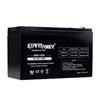 | ExpertPower Type: Sealed Lead Acid Product Dimensions: 5.9 x 2.5 x 3.7 inches | Check Price |
Chrome Battery 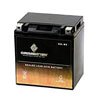 | Chrome Battery Type: Sealed Lead Acid Product Dimensions: 6.5 x 5 x 6.9 inches | Check Price |
Battery Tender 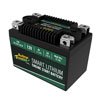 | Battery Tender Type: Lithium Product Dimensions: 4.5 x 2.8 x 3.4 inches | Check Price |
ThrottleX Batteries 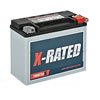 | ThrottleX Batteries Type: AGM Product Dimensions: 6.9 x 3.4 x 6.1 inches | Check Price |
Yuasa 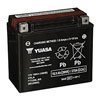 | Yuasa Type: Sealed Lead Acid Product Dimensions: 6.9 x 3.4 x 6.1 inches | Check Price |
Mighty Max 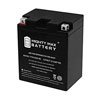 | Mighty Max Type: Sealed Lead Acid Product Dimensions: 5 x 3.5 x 6.5 inches | Check Price |
Deka 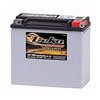 | Deka Type: AGM Product Dimensions: 6.9 x 3.4 x 6.1 inches | Check Price |
Pirate 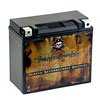 | Pirate Battery Type: AGM Product Dimensions: 6.9 x 3.4 x 6.1 inches | Check Price |
ExpertPower – Best User-Friendly
This is a 12-volt 7-Amp sealed lead acid type with F1 style terminals. The discharge temperature is -40°F to +140°F, while the recharge temperature is 4°F to 122°F.
It comes in an impact-resistant case that’s made of non-conductive ABS plastic. It’s highly resistant to shock, chemicals, vibration, and heat.
The acid inside is absorbed between plates, and immobilized by a fiberglass mat. It’s a low-risk option, providing safe operation with a spill-proof design.
Another thing worth noting is that this one comes as a single battery or in a pack of ten. The one-time installation of the valve-regulated models allows easy use. It takes four hours to charge, and it’s going to provide quite a long time of use.
PROS
- Comes in a pack or as a single
- Safe operation
- Impact-resistant case
CONS
- It beeps very quietly
Chrome Battery – Best Smart Technology
This is a 12V, 360Watts rechargeable, sport model. While you can use it for motorcycles, it also works on jet skis, ATVs, and much more.
It features the well-known Absorbed Glass Mat technology with the acid constructed inside. This allows low-maintenance and provides a spill-proof performance. On top of that, it features a patented sealed post to prevent corrosion and extend its life.
It’s important to note that this one comes fully charged, so you can use it right when it arrives. Just connect it to your bike or another vehicle, and it’s ready to go.
Overall, it’s a popular choice because it comes with some new hardware. Precisely, it comes with two sets of screws and backing plates. It’s easy to fit into your box.
PROS
- Long and short screws included
- Sealed post
- It comes pre-charged
CONS
- A bit tricky to install
Battery Tender – Best Smart Charging
If you’re looking for a small and lightweight solution for your bike, you might want to consider this one. It measures 113mm x 70mm x 85 mm, weighing only 1.35 pounds in total. It’s easy to install, although it doesn’t come with any tools or hardware.
It features a built-in protection circuit board that prevents it from overcharging, over-draining, and discharging as well. When it detects voltage that’s below a certain threshold, it shuts itself off. This is to prevent permanent damage.
What it does come with is an activation switch on the Quick Disconnect Cable. This activates Smart Charging, making it easy to use and work with.
Keep in mind that this one comes in several variations, depending on the exact capacity you need. All of the variations are of equal size.
PROS
- Smart charging
- Built-in protection circuit
- Small and compact
CONS
- It’s incompatible with many different motorcycles
ThrottleX Batteries – Best Maintenance-free
If you, like many people, are interested in as little maintenance as possible, you should try this model. It’s maintenance-free, which is why it’s often a choice of many bikers. On top of that, it comes fully charged and ready to install.
When it comes to power, this one sports 310 CCA and 18 AH in a compact case. It measures 6 7/8 in length, 3 7/16 in width, and 6 1/8 in height. It weighs some 16 lbs, which some consider a bit on a heavy side.
It’s also important to mention its Absorbed Glass Mat non-spill sealed technology. It makes for safer use, especially since it’s combined with a heat-sealed cover.
Also, it comes with solid lead female threaded terminals.
PROS
- Non-spill technology
- Maintenance-free
- Stainless steel bolts included
CONS
- It’s not meant to sit for a long time
Yuasa – Best Spill-proof
This one is also available with a charger if you don’t already have one. It sports 12 volts, 18 amp-hour, and 270 cold cranking amps. On top of that, it’s also maintenance-free.
Its case is totally sealed and spill-proof since all the acid is absorbed in special plates. It’s also absorbed in glass mat separators. Thanks to such an advanced system, it’s unlikely that it could ever spill.
Another thing worth mentioning is the advanced lead-calcium technology. This holds the specific gravity up to three times longer than some more conventional options.
Keep in mind that this one comes dry, but you get an acid bottle in the package. Make sure to operate it carefully and with all the safety measures.
Also, the box measures 6.87’’x3.43’’x6.12’’ in total. In most cases, it fits different bikes and vehicles, but make sure to check its compatibility nonetheless.
PROS
- Spill-proof design
- Available with a charger
- Lead-calcium technology
CONS
- It arrives dry
Mighty Max – Best Shook-proof
If you’re looking for a rechargeable product that’s resistant to shock and vibration, you might want to check this one. It features 12V, 12AH, and 210 cold cranking amps.
It measures 5.20×3.50×6.40 inches in total while weighing some 10 pounds. Positive is on the left, and negative is on the right, but keep in mind that no wire harness is included. It comes with no mounting accessories, so you’d have to purchase that separately.
It’s a spill-proof model with wide operating temperatures, deep discharge recover, and long service life. It’s shook-proof, which is also quite important.
The manufacturer offers a 30-day refund and a full year of warranty you can rely on. When it comes to the installation process, the reviews are somewhat mixed. Some people think it’s a bit complicated.
PROS
- For all-terrain vehicles
- Shook-proof
- Long service life
CONS
- Somewhat tricky to install
Deka – Easiest to Install
This Deka Sports AGM provides power and value, allowing you to use it for a longer period. It’s suitable for motorcycles, watercraft, snowmobiles, ATVs, and other such vehicles.
It’s spill-proof, providing season-to-season reliability in terms of maintenance. It helps prevent frequent replacements, delivering quality performance.
Also, its absorbed glass mat technology increases power but also improves environmental and rider safety. This is an important factor you should always consider.
The technology consists of highly porous microfiber separators that absorb and trap the electrolyte. Its molded top and side terminals increase strength and durability, while also providing versatility.
Overall, you’ll find no spill, drip, or any other issues with acid possibly eating your chrome. This option is safe to work with and quite easy to install in most motorcycles and other vehicles.
PROS
- Spill-proof technology
- Easy to install
- For different vehicles
CONS
- 6-months warranty
Pirate Battery - Best Versatile Fit
Pirate is a popular choice due to its compatibility with many different motorcycles and vehicles. It’s a rechargeable model with a versatile fit so that you can use it on your bike, jet ski, ATV, and more.
This one also features Absorbed Glass Mat technology that the acid is trapped in. This allows low-maintenance and makes it spill-proof.
On top of that, it features a sealed post which prevents corrosion and extends the overall life.
Another vital thing to mention is its general ease of use and installation. It comes fully charged so that you can use it right when it arrives.
All you have to do is to connect it to the application, and it’s ready to go.
PROS
- Rechargeable
- Spill-proof
- Easy to install
CONS
- No screws or nuts included
Factors to Consider When Buying
Voltage
The average voltage is 12-volts, which is ideal for a full-size bike. If you have a smaller bike, you probably want to go for a 6-volts battery.
The best way to go about this is to check your current battery. Take a look at its listings and specifications so that you can get another one with the same specs. This way, you minimize the chance of damaging your bike with an incorrect model.
This is what helps your bike run, so its voltage is a serious matter that’s not to be played with. A battery with a voltage that lower or higher than what your bike needs might not perform as well.

Type of Terminal Post
When you get to replacing the batteries, you’ll have to decide between different terminal posts. The main types are inset screw-type terminals and exposed lead posts.
Both types are fine and work equally as efficiently. Some people consider the screw post terminals somewhat more convenient, but it all depends on your preference.
Keep in mind that exposed lead terminals are vertical, while screw posts are horizontal. This can make it a bit more challenging to change and rearrange wires in a tight space such as the battery compartment.
Though both types work, you will have to bend and rearrange wires if you’re switching between these two.
Buy From Reputable Brands
A quality product from a reputable brand is always a better choice than maybe a cheaper one manufactured by a less-known brand. Much like in all industries, reputable brands usually sell their products through their distribution channels, private label brands, and retailers.
Finding a reputable brand isn’t that tricky as long as you pay attention to customer reviews and ratings.
Original equipment manufacturers (OEM) add significant innovation and value in how they make and take their batteries to market.
Sales and product line breadth also have a lot to do with whether a brand is safe and reliable. A few of those stand out on the market, and we’ve included several in our reviews above.
When looking for a new option, make sure to consider brands like MotoBatt, ACDelco, Yuasa, ThrottleX, and Chrome Battery.
Cold Cranking Amps
Cold cranking amps (CCA on batteries) refers to the power that the battery can get when starting the bike in the cold. This is a raw number that’s quite a good indicator of the power and ability to discharge it at once.
CCA usually depends on construction type, battery type as well as internal components. In most cases, it might be good to go with an option that has higher CCA if you’re choosing between two different models.
However, if you aren’t sure how many CCA you should go for, we suggest that you check with your manufacturer’s OEM specifications. You can find this online or in the service manual if you have it.
You should go for the highest possible CCA battery only if you plan to start your bike in freezing cold regularly. Since most people don’t ride in such temperatures, CCA horsepower is used as a comparison between two options.
Again, choosing CCA is up to you, depending on your needs and preferences. However, don’t forget to consult with the manufacturer.
Measure the Size
The size is probably the most important factor to consider when buying one. Replacements have to fit in exactly where the previous battery came from, which is why you should double-check the size. Luckily, popular motorcycle models have exact alternatives available.
Nonetheless, you should always measure the width, length, and height of the model that you’re replacing. Then, compare the dimensions to the one you’re looking to replace it with before you actually purchase it.
An option that’s too small can still work. It will save on weight and be quite advantageous as long as its performance isn’t compromised.
If you do end up with a smaller one, don’t forget to fill the gaps around it with a rag or foam. Find something soft that prevents it from vibrating and moving during use.
Number of Amp Hours
This number refers to how long your battery can produce certain amps of output. For example, one with 12 amp hours provides 1 amp at 12 volts for 12 hours. It’s the same way that a model with 6 amp hours produces 1 amp at 12 volts but for six hours.
If you’re wondering how many amp hours you need, you should know that it depends on amps of power your motorcycle pulls. It also depends on how well your alternator changes it.
In most cases, it’s best to go for what your manufacturer recommends. You can even ask your dealer or mechanic if they can recommend the appropriate amp hour model.
Though there’s a way to measure how much amperage your bike draws from the battery, that’s a bit complicated to explain. For this reason, you might want to either go with what the professionals recommended.
Types & Differences
Wet Lead Acid
Lead acid batteries are conventional models. You can usually tell them apart from others by a row of plastic stoppers in the top. There are three stoppers if it’s a 6-volt type and six stoppers if it’s a 12-volt type.
Lead acid batteries tend to have higher and lower acid levels on the front. In most cases, they have a white plastic lower casing. It’s important to note that the reference numbers usually start with letters YB, GB, or CB.
These hold the cell’s electrolytes in a liquid acid. When charging or discharging, these give off hydrogen gas that’s highly toxic and explosive. For this reason, these have to be periodically checked. You need to get them topped up with distilled water because it gets used up over time.
AGM (Absorbed Glass Mat)
These have low internal resistance and deliver high currents on demand. They have a long service life and are usually maintenance-free. This offers a dose of reliability, especially because they’re less prone to sulfation.
AGM batteries can sit in storage for a long time and can endure low temperatures. Probably the most significant advantage of these is that they can charge up to five times faster than the wet lead acid types.
Still, there are some drawbacks. An AGM has lower specific energy and is usually more expensive than a flooded battery.
It’s the preferred option for upscale bikes. Because it’s sealed, it reduces acid spilling in case of an accident. Also, this allows you to install it at odd angles if you ever need to. It’s not as heavy either.
Gel Cell
In most cases, these come in a black, grey, or blue casing and a matching top. The battery number usually stars with CT, YT, GT or YTZ, GTZ, or CTZ.
These are filled with a gel state acid but don’t require any topping. They’re sealed in the manufacturing process, which allows you to install them at an angle. The gel acid won’t move around in battery.
Its electrolytes are encased in fumed silica (gelling agent), which is what keeps the acid in a jelly state. Again, these are hermetically sealed and not refillable. This means they’re maintenance-free, so you don’t have to remove the top and check the acid level.
Other Additional Features to Consider
Price
Price usually ranges from brand to brand, and it depends on several factors. However, you should confirm that the cost is lower or at least close to the advised retail price.
Also, consider your budget in the long run. Think about the maintenance cost if you’re not going for a maintenance-free option.
Discharge or Charge Cycle
Every model comes with a unique number that states the discharge or charge cycle before it’s worn out. While each model has its own number, the most common one you’ll come across is 500 to 1200.
Warranty Coverage
Warranty is always important to consider, more so if you’re buying an expensive model. Look for a brand that covers its product for at least a year, although many manufacturers offer more.
Your option should last you a few years, so you might want to reconsider going for the one that’s only covered for a few months.
Read Customer Reviews
Customer reviews are a great source of information where you can find many details on how the battery performs. Past customers usually leave reviews after some time of use, so you can figure out if your prospect is worth it or not.
This kind of information helps you have a better understanding of a model’s performance, ease of use, and general maintenance.
Weather Condition
Think about where you’ll ride the bike and what’s the weather like there. The weather actually plays a significant role in how your battery performs.
We’ve mentioned how starting the bike in the cold isn’t the same as starting it in hot weather. Also, if you live in a warmer temperature, you might want to go for the one with longer life.

Riding Style
Your riding style should also affect which battery you’ll purchase. Daily commuters need a different type than those who only ride a few times a month.
This is why the model of your choice should match your bike and all its requirements.
Important Tips for Users
You should take note of any maintenance tips you received from the manufacturer. These first-hand tips are the most efficient and usually play a big role in longevity.
All batteries are different, so don’t overlook the following instructions properly. Instructions on how to properly care for them are critical and should be followed without excuse.
Some of the most significant parts of your battery are its terminals. For this reason, you should correctly maintain them at all times.
You should also check all the cables regularly to ensure that they’re always in the best condition.
Make sure to take a moment at least once a month to visually inspect your battery. This way, you can notice any issue and act accordingly on it. Failing to do this could lead to more severe danger.
Frequently Asked Questions
What's the best motorcycle battery for cold weather?
In most cases, lithium motorcycle batteries are great for cold weather. However, this is only if you give it enough wake-up time.
If you’re looking for a battery to perform in freezing temperatures and without the wake-up sequence, lithium might not be the best for you.
Go for a battery with the highest CCA if you’re looking for one to perform in such cold weather.
What's the best type of motorbike battery?
This is entirely optional as it depends on the motorcycle you have as well as your own preferences and needs. As we mentioned, your best battery might not be the best for someone who lives in tropical weather.
In most cases, people go for maintenance-free batteries because they don’t require any maintenance and are generally cost-effective.
What battery is best for electric bike?
Lithium-based batteries are the most common choice for electric bikes. Still, you should consider the specific bike you have, as well as your riding style, charge cycles, weight, and capacity of the battery you’re interested in.
Conclusion
If you came this far, you probably have a good idea of what is the best motorcycle battery. Hopefully, our buyer’s guide helped you figure out which model would be the best for your bike and its needs.
Keep in mind that your battery should last you a long time while always performing at a satisfactory level. This is why you shouldn’t compromise quality because of the price or anything else.
Though this much information might seem a bit overwhelming, using the stuff from our buyer’s guide can help you choose one of these batteries. However, keep in mind that you should consider all the important buying factors before you actually make a purchase.














